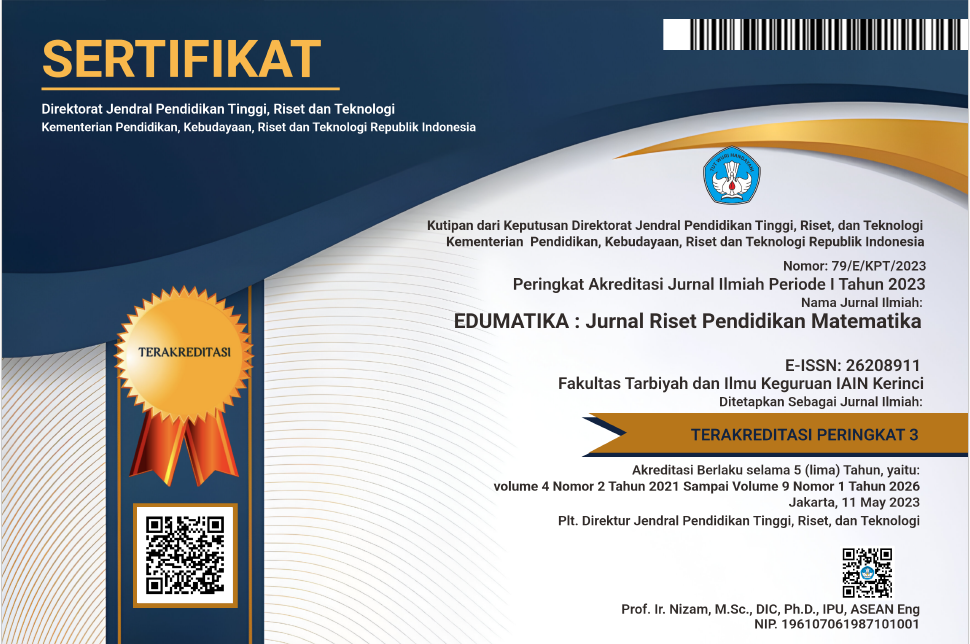How do Students Think in Translating Verbal Representation to Graphics?
Abstract
This research is based on the variety of students' work in completing mathematical translations, especially from verbal representations to graphs. This study aimed to analyze the path of students' mathematical translation thinking from verbal representations to graphs. Thirty-two students were involved in completing the mathematical translation task, and four students were selected as research subjects. The supporting instruments in this research are in the form of mathematical translation tasks and interview guidelines. The data analysis step begins by grouping the students' work and making a transcript of the interview results. Next, the researcher explored and coded the students' work, found differences in the mathematical translational thinking path, explained the mathematical translation process for each path, reported the findings, interpreted the findings, and validated the research results by triangulating data sources. This study resulted in two types of students' mathematical translational thinking paths, namely the complete and incomplete construction translational thinking path. The difference between these two paths lies in the completeness of cognitive activity in each step of mathematical translation. The results of this study are used as considerations in designing meaningful mathematics learning activities.
Downloads
References
Abdullah, A. H., Zainal, N. L., & Ali, M. (2015). Analysis of Students’ Errors in Solving Higher Order Thinking Skills (HOTS) Problems for the Topic of Fraction. Asian Social Science, 11(21).
Adu-Gyamfi, K. A., Schwartz, C., Sinicrope, R., & Bossé, M. (2019). Making sense of fraction division: Domain and representation knowledge of preservice elementary teachers on a fraction division task. Mathematics Education Research Journal, 31.
Adu-Gyamfi, K., Bossé, M. J., & Chandler, K. (2017). Student Connections between Algebraic and Graphical Polynomial Representations in the Context of a Polynomial Relation. International Journal of Science and Mathematics Education, 15(5), 915–938. https://doi.org/10.1007/s10763-016-9730-1
Adu-Gyamfi, K., Stiff, L., & J. Bossé, M. (2012). Lost in Translation: Examining Translation Errors Associated with Mathematical Representations (Vol. 112). School Science and Mathematics. https://doi.org/10.1111/j.1949-8594.2011.00129.x
Afriyani, D. (2018). Karakterisasi Proses Berpikir Pseudo-Translasi Antar Representasi Matematis. Univesitas Negeri Malang.
Afriyani, D., & Pramita, D. (2021). Mengekplorasi Pemahaman Matematos Siswa dalam Penyelesaian Soal Translasi Matematis. AKSIOMA: Jurnal Program Studi Pendidikan Matematika, 10(3).
Afriyani, D., Sa’dijah, C., Subanji, & Makbu, M. (2018). Characteristics of Students’ Mathematical Understanding in Solving Multiple Representation Task based on Solo Taxonomy. International Electronic Journal of Mathematics Education, 13(3), 281–287.
Afriyani, D., & Yuberta, K. R. (2019). Exploring the cognitive process of prospective mathematics teachers in constructing a graph. Beta: Jurnal Tadris Matematika, 12(1), 26–42.
Arnon, L., Cottril, J., Dubinsky, Ed., Oktac, A., Fuentes, S. R., Trigueros, M., & Weller, K. (2014). A Framework for Research and Curriculum Development in Mathematics Education (Springer).
Association of Mathematics Teacher Educators. (2017). Standards for preparing teachers of mathematics.
Bossé, M. J., Adu-Gyamfi, K., & Chandler, K. (2014). Students’ Differentiated Translation Processes. International Journal for Mathematics Teaching and Learning, 1–28.
Hamda. (2020). Berpikir Konstruksi Lengkap dalam Pemecahan Masalah Matematika dan Implikasinya dalam Kehidupan Nyata. Universitas Negeri Makasar.
Leinhardt, G., Zaslavsky, O., & Stein, M. (1990). Functions, Graphs, and Graphing: Tasks, Learning, and Teaching (Vol. 60). https://doi.org/10.2307/1170224
Lesh, R., & Behr, M. (1987). Representation and Translations among Representations in Mathematics Learning and Problem Solving. C. Janvier, (Ed.), Problem of Representations in the Teaching and Learning of Mathematics. Lawrence Erlbaum.
Lilia, S. (2017). Proses Berpikir Mahasiswa dalam Menyelesaikan Soal Kombinatorik Berdasarkan Kecerdasan Logis Matematis. Universitas Nusantara PGRI Kediri.
Muttaqien, A. (2016). Rreprsentasi Matematis Pada Pemecahan Word Problem Perbandingan Inkonsisten. Jurnal Review Pmbelajaran Matematika, 1(2).
Rau, M., & Matthews, P. G. (2017). How to make ‘more’ better? Principles for effective use of multiple representations to enhance students’ learning about fractions. ZDM, 49(4).
Roth, W. M., & Bowen, G. M. (2001). Professionals Read Graphs: A Semiotic Analysis. Journal for Research in Mathematics Education, 32(2), 159–194. https://doi.org/10.2307/749672
Zulianto, R., & Budiato, M. T. (2020). Kemampuan translasi representasi matematis siswa kelas VIII SMP dalam menyelesaikan soal kontekstual. JKPM (Jurnal Kajian Pendidikan Matematika), 5(2).
Copyright (c) 2022 Ummul Huda, Dona Afriyani, Mardiana Mardiana, Wiladahtul Fitri

This work is licensed under a Creative Commons Attribution 4.0 International License.















